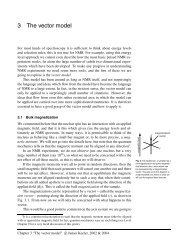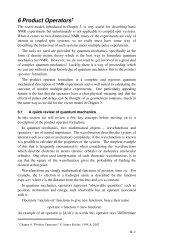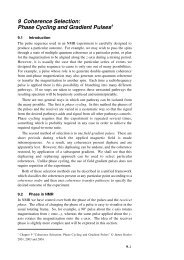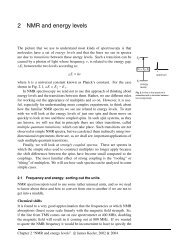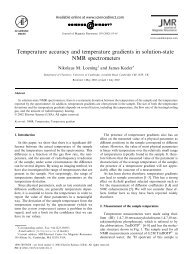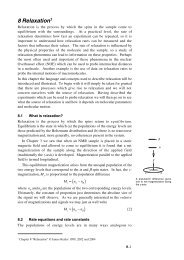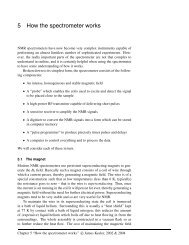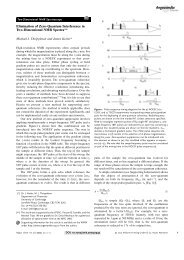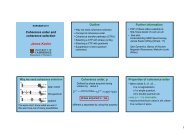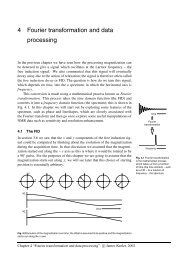Phase Cycling and Gradient Pulses - The James Keeler Group
Phase Cycling and Gradient Pulses - The James Keeler Group
Phase Cycling and Gradient Pulses - The James Keeler Group
You also want an ePaper? Increase the reach of your titles
YUMPU automatically turns print PDFs into web optimized ePapers that Google loves.
φ sig<br />
, is measured anti-clockwise from the x-axis. <strong>The</strong> dot shows the axis along<br />
which the receiver is aligned; this phase, φ rx<br />
, is also measured anti-clockwise<br />
from the x-axis.<br />
If the vector <strong>and</strong> receiver are aligned along the same axis, Φ = 0, <strong>and</strong> the real<br />
part of the spectrum shows the absorption mode lineshape. If the receiver<br />
phase is advanced by π/2, Φ = 0 – π/2 <strong>and</strong>, from Eq. [1]<br />
S( ω)= B[ A( ω)+ iD( ω)<br />
] exp( −iπ<br />
2)<br />
= B − iA( ω)+ D( ω)<br />
[ ]<br />
This means that the real part of the spectrum shows a dispersion lineshape. On<br />
the other h<strong>and</strong>, if the magnetization is advanced by π/2, Φ = φ sig<br />
– φ rx<br />
= π/2 – 0 = π/2 <strong>and</strong> it can be shown from Eq. [1] that the real part of the<br />
spectrum shows a negative dispersion lineshape. Finally, if either phase is<br />
advanced by π, the result is a negative absorption lineshape.<br />
y<br />
x<br />
φ rx<br />
φ<br />
9.2.6 CYCLOPS<br />
<strong>The</strong> CYCLOPS phase cycling scheme is commonly used in even the simplest<br />
pulse-acquire experiments. <strong>The</strong> sequence is designed to cancel some<br />
imperfections associated with errors in the two phase detectors mentioned<br />
above; a description of how this is achieved is beyond the scope of this<br />
discussion. However, the cycle itself illustrates very well the points made in<br />
the previous section.<br />
<strong>The</strong>re are four steps in the cycle, the pulse phase goes x, y, –x, –y i.e. it<br />
advances by 90° on each step; likewise the receiver advances by 90° on each<br />
step. <strong>The</strong> figure below shows how the magnetization <strong>and</strong> receiver phases are<br />
related for the four steps of this cycle<br />
9–6



